Note: This review has been updated on May 20, 2015 in order to include the changes reflected in the second production batch of this flashlight as well as details on the other two UV and NW versions.
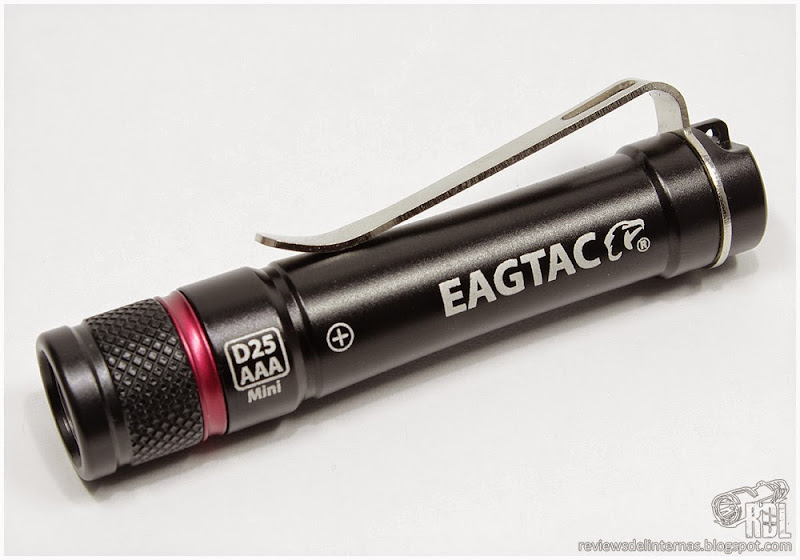
EAGLETAC D25AAA Mini
LED: CREE XP-G2 S2
Battery: 1x AAA, 1x 10440
Modes: 3 (Low, Medium, High) + 7 Auxiliary
Switch: Twisty
Date: March 2015
Links:
Eagletac · Flashaholics.co.uk · NKON · RdL · ForoLinternas
INTRODUCTION:
Eagletac recently launched a new addition in its D range, thus filling an important gap in their EDC line with a single AAA flashlight. This new D25AAA comes in two different versions, differentiated by the type of LED emitter, Cree XP-G2 S2 for cool white version, and a Nichia 219B (CRI 92) for version neutral/warm white, and recently has added a new model, this time with UV light with an Edison Opto emitter of 395nm of wavelength. The model we are going to review today is the cool white.

The presentation of this small flashlight is quite minimalist, arriving in a small cardboard box, in which in addition to the flashlight we find just a couple of spare o-rings and the user manual of the flashlight.

Eagletac sells this model in four different finishes, which are placed four different colors for the anodized ring visible between the head and the body of the flashlight. Available in red, yellow, blue and gray.

###Update, 5/20/2015###

Thanks to Eagletac, who have kindly provided me a test samples for the Nichia 219B and Edison Opto UV models, I’ll update this review with some interesting details about the performance of the neutral version of this flashlight, and show the little design changes which makes now possible to remove the flashlight clip if desired.

EXTERIOR FINISH:
The design of this new Eagletac is quite peculiar, with some very personal traits. The material used for construction is aluminum and is finished with a matte black HAIII anodizing, except for the aforementioned ring at the junction of the two pieces.

We found a highly visible logos on the body, with excellent contrast and very well defined.
The head of the flashlight features a non-aggressive knurling track which greatly facilitates one-handed operation of twisty. Headlight optics is composed of a TIR lens, which produces a ~ 20º hotspot and 55º spill according to specifications.
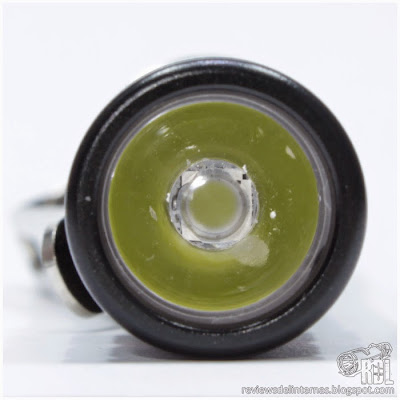
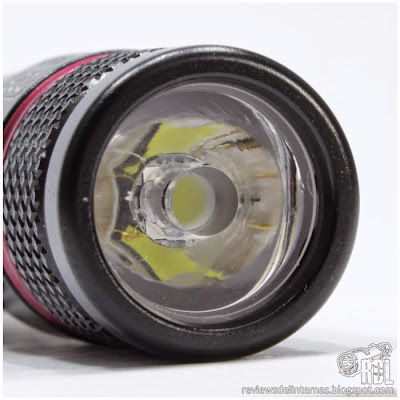
The XP-G2 is a little blurred inside the lens, with a little cleaner look.

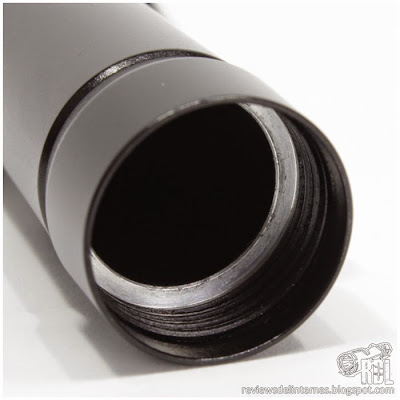
The threads are anodized, and are part of the led engine containing both the driver and the LED. The electrical contact between the two parts of the flashlight is made by the driver and a step anodizing-free found in the tube, thus preventing future wear of the anodized threads which could cause problems in the activation or modes change.
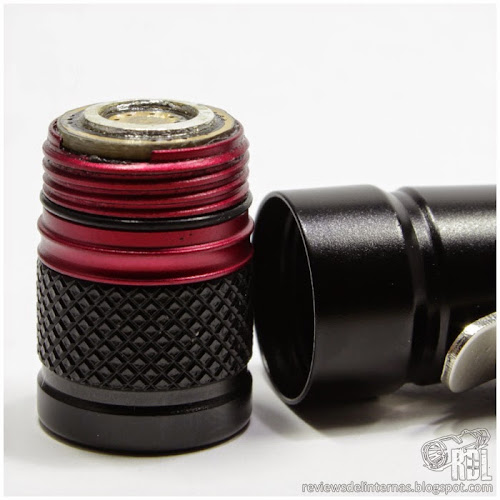
The tube has a peculiar design, since instead of the classic straight design, Eagletac machined this piece with a slight taper shape.
The pocket clip looks pretty robust, and is quite large and bulky. It strikes me that contrary to as announced in the beginning it’s not removable.
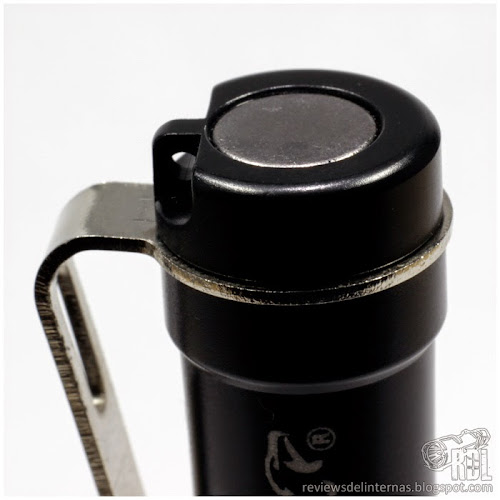
In the tailcap we have a small but powerful “rare earth” magnet embedded in the flat base which is capable of holding the flashlight to any iron surface safely.
###Update, 5/20/2015###
The second batch of D25AAA out has now no thread glue/seal in the tailcap, enabling removing the pocket clip. So we must unscrew the tailcap of the flashlight, which holds the clip by pressure in the housing. The clip is also fixed in one position as the profile sits in a groove, preventing rotation within its housing. This change may seem small or insignificant, but will remove a certainly unnecessary bulk if we choose to take our D25AAA on keychain, or if you just prefer it without the clip for any other reason, and gives the user the opportunity to decide, something always very welcome .




Moreover, both the machining and the overall construction of the flashlight remains unchanged, as we saw weeks ago.
We can see how the tone of phosphorus which is reflected in the TIR lens shows clearly the difference between different LED emitters, with Nichia 219B showing a darker yellow than the Cree cold tinted version, and UV shows a gray color for the absence of phosphorous coating in the emitting surface inside the dome.

USER INTERFACE:
Faithful to its principles, the D25AAA user interface is simple but very complete. We have three different intensities, and a few hidden strobe modes.
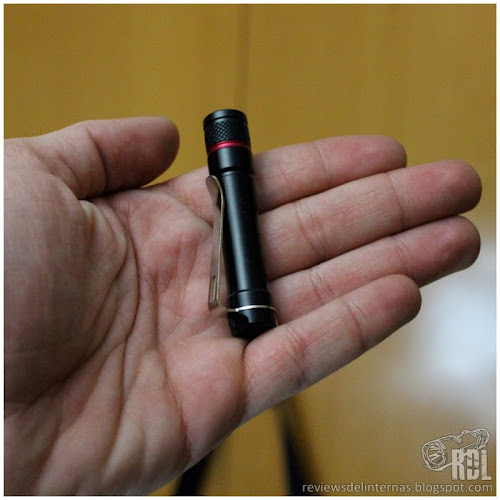
- On and Off: The D25AAA is turned on by completely threading the the head, and off reversing the operation.
- Changing Modes: As in most twisty flashlights, modes will alternate between performing on-off-on within two seconds. The order of the modes is rising, Low-Medium-High, with no memory.


- Hidden strobe modes: The seven auxiliary modes are hidden at the end of the sequence of modes and to access we must make six interruptions, or what is the same, switch between entire three modes sequence twice. The repertoire of “disco” modes is common in the Eagletac D range with three different frequency strobes, two SOS modes with different speeds and two beacon or signaling modes.

<span class=“activation after seconds 120 and 30 between reading highest taking FL1”:Estándares ANSI NEMA FL1 - ForoLinternas - Foro sobre linternas y tecnología LED, NEMA “ANSI procedure the following taken are measurements All”>
It is curious that there are two kinds of discrepancies between specified by the manufacturer and measured in an integrating sphere, being less than specified low and medium modes, unlike the High mode that exceeds around 10LM the 85LM spec’d by the brand. I consider the distribution of three intensities very nice. The low and medium modes are performed by PWM, although very high frequency so they are not visible to the naked eye.
###Update, 5/20/2015###

For Nichia 219B specifications for this Eagletac D25AAA I had to calculate by percentage with reference to the single specification provided by the manufacturer’s technical page on the model, where they state 68LM ANSI for the High mode in this neutral light model. Reference 85LM ANSI for the XP-G2cold tinted version gives us a loss of 20% brightness, something that after the mode test is constant along different output levels.
PERFORMANCE:

Slightly exceeding the actual 100LM barrier at activation, the D25AAA at its highest mode shows a perfectly linear output of 95LM for about half an hour until loses regulation. The Med mode also shows a flat regulation with approximately 70 minutes of 25LM. Both modes seem to be well below my expectations on efficiency for this little flashlight.

Here we compare one of the great attractions of the D25AAA: its “official” support for li-ion batteries. With a 10440, it exceeds broadly the 300LM at activation, and shows an unregulated curve for about 25 minutes, at which point it stabilizes briefly matching with the NiMH battery line, to almost instantaneously lose regulation although never switching off completely.

Finally, comparison between popular AAA flashlights in this segment, all fed by an “800mAh” Eneloop AAA. The Eagletac is the most powerful wagon, surpassed only by the enormous power of the Thrunite Ti powered by a XP-L, and the surprising Maratac AAA copper REV3.
###Update, 5/20/2015###

The performance of the neutral version offers a “twin” curve, so I imagine the driver used is the same for all versions, and the difference is referred simply to the different efficiencies, about 20% less in the Nichia 219B.
BEAM PROFILE:
The profile of this small flashlight is quite floody, with a large hotspot which covers about 50% of the illuminated area. The use of a TIR lens is probably the reason that the beam shows a completely uniform in color tone, without the classic halos of different shades of color in the corona surrounding the hotspot.

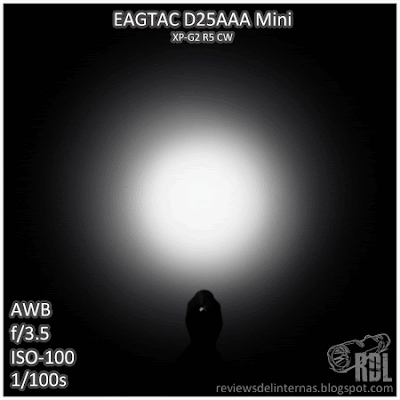


The tint is cool white, without a dominant color. In this regard I have been pleasantly surprised since seeing that use a bin so high for the XP-G2 I expected a trend toward green. Good job!
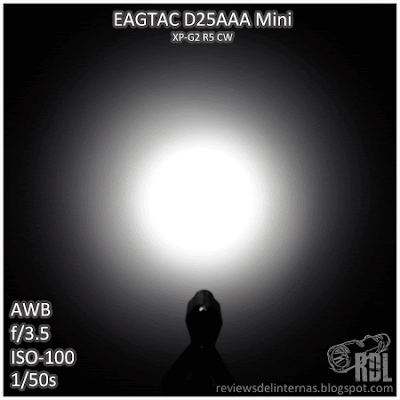

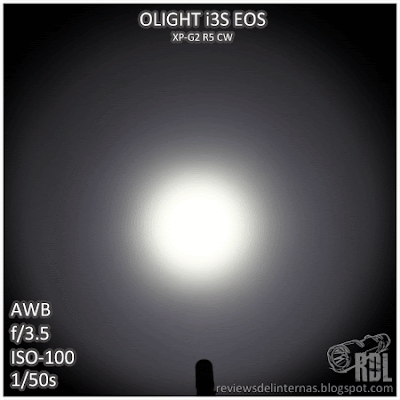
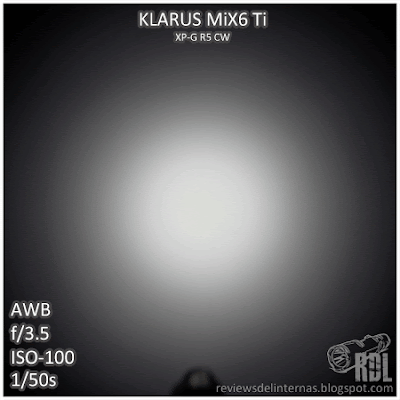
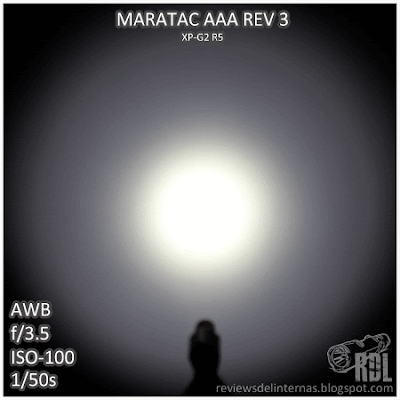
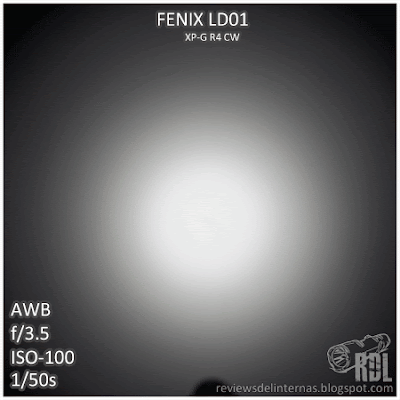
###Update, 5/20/2015###
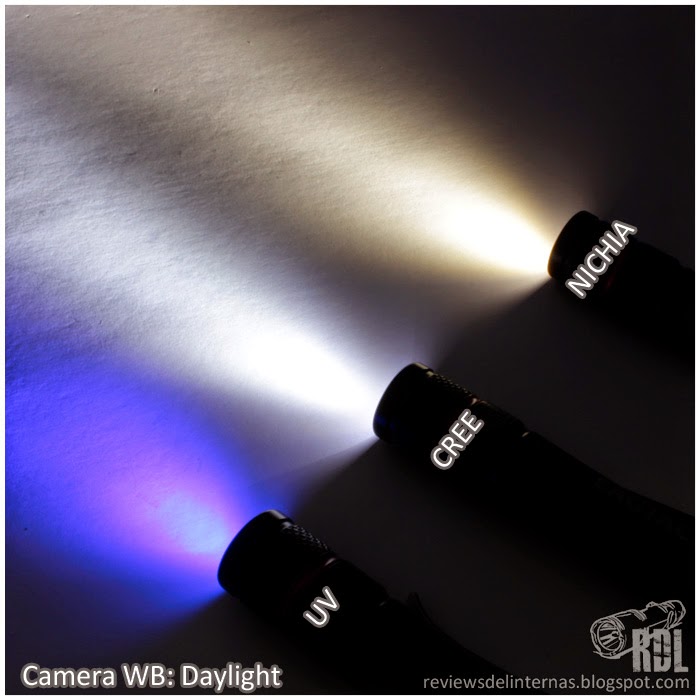
The Nichia 219B tint is excellent, neutral white with a very good response as far as color representation is concerned. Not surprisingly, the color rendering index (CRI) reaches level 92 out of 100, where the maximum would be the quality of sunlight in color reproduction. This LED emitter, though still below as far as efficiency and maximum output is concerned, offers a much more natural and true light very close to would be in broad daylight, showing to our eyes the colors and tones in a much more reliable way to which the popular LED cold light offers.
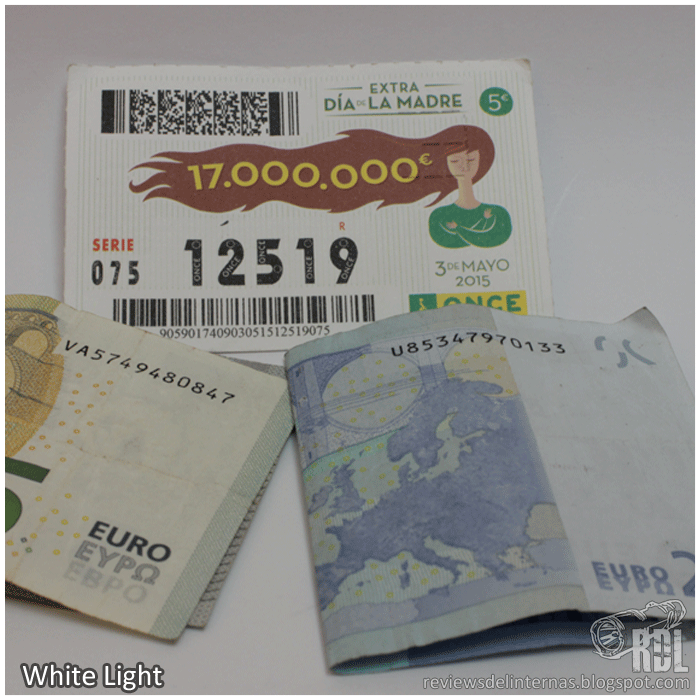
Finally, we have the UV version of this D25AAA, which offers a truly portable source of ultraviolet light, with all the peculiarities of the other two versions of white light. The emitter used for this ultra-violet version is an Edison Opto LED with a wavelength of 395nm. This means we can expect a lot of visible light as the invisible range of the spectrum in the UV light is slightly below. In addition, this UV version retains modes the same way as the other two versions of white light, which makes it very useful to shed a small amount of UV light on documents or tickets to watch their brands without becoming blind by excessive visible light.
The flashlight shows a twin beam profile of their versions of white light, with a considerable amount of visible light with a violet tint.
PERSONAL CONCLUSION:
It is clear that this new D25AAA is a flashlight that fills a big gap for a long time within the wide range of products Eagletac offers. Within the D series, which could classify as EDC or polyvalent flashlights, the D25AAA is a flashlight that provides an ultraportable size with a common user interface with the other “pocket-friendly” models as the D25A or D25C.


Eagletac D25AAA · Bronte RA01ss · Nextorch K10 · Nitecore T2s · Olight i3S · Fenix LD01
The external appearance of the flashlight has a very elegant touch, with a very own machining and some details that give that special touch.
Negatives: The first negative aspect is undoubtedly the great disproportion between the body of this flashlight and clip. It is always appreciated that small AAA flashlights include a nice clip, but the one provided here seems too big. In addition, this clip was initially removable but for some reason Eagletac decided to leave it fixed, so that it is virtually impossible to remove without risk of damaging the flashlight. In another sense, I must admit that I expected much more from this D25AAA as far as performance is concerned, as neither of the two modes I’ve tested seems to be on top of class efficiency. Finally, add a magnet on the tailcap of a flashlight is always quite useful as it will allow us to use it in “hands-free” mode, but everyone knows that magnetism can play tricks if we keep it in the same pocket with magnetic bands like those of our credit cards. It would have been great if, for example as in small Olight Batons, the user could easily remove the magnet.
Positives: The use of small lens TIR is undoubtedly responsible for that so clean beam profile, in which only one can notice a single color, contrary to what usually happens with LEDs combined with reflectors where we always warn a yellowish or greenish color light surrounding the hotspot. In this sense, this D25AAA even with an XP-G2 bin S2, the highest to date, produced an exquisite beam. The touch of color added to the ring at the junction between the two pieces is also a nice touch to the customization of something as personal as a flashlight keychain, giving us the opportunity to choose the combination that we like without eliminating the sober and always neat black anodizing.